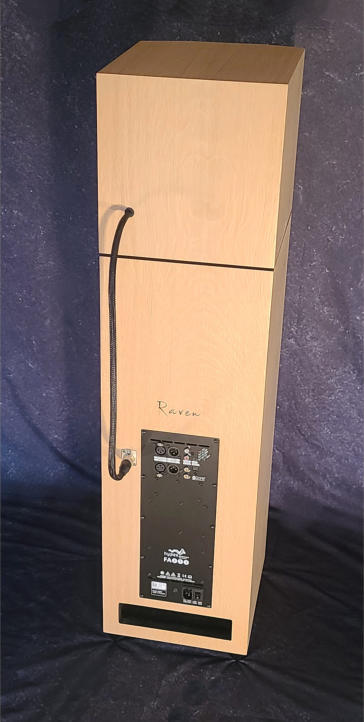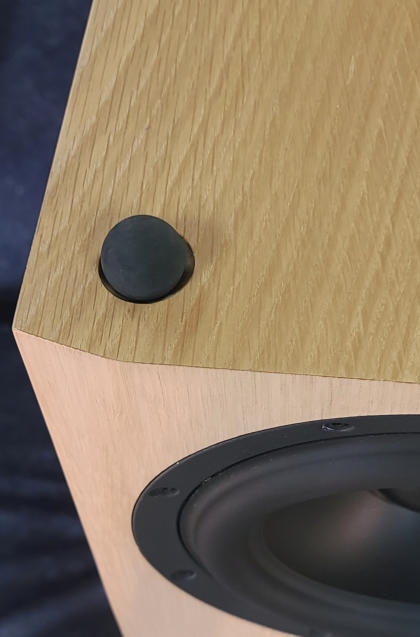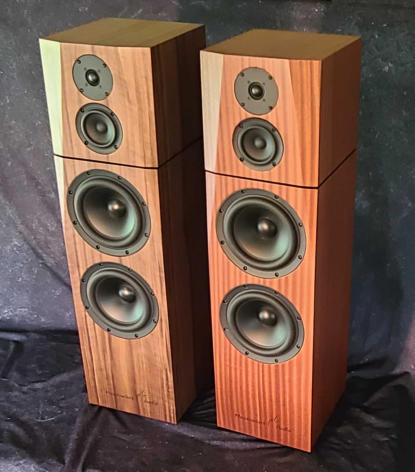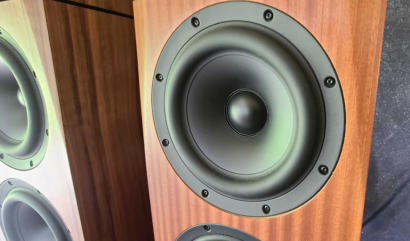SPECIFICATIONS:
100X250X250W Hypex NCore
Dual 9.5” subwoofers
Total bass system displacement
per side = 0.882 liters
Ultra low mass 4” midrange
Seas non-ferrofluid tweeter
Elastically decoupled mid/tweeter enclosure
Heavily braced, triangular midrange wavetrap
enclosure with 3M industrial vibration
absorbing constrained layer damping, heavy
felt and natural fibrous fill
Digital inputs to 24bit 192KHz
SPDIF and AES/EBU and Optical inputs
Analog inupts by RCA and XLR
Auto signal detect
Three Presets
Adjustable bandwidth
Digital signal cables included
Cubby at rear hides your streamer
Net weight 85lbs.
Shown in White Oak, Figured Black Walnut
and Sapele
RAVEN BREAKS THE MOLD: A TWIN SUBWOOFER, TRIAMPLIFIED THREE-WAY
Since the beginning of audio, a three-way’s bass system had to be a woofer, maybe two. A woofer is a driver
that, by design, must divide its duties between making bass and doing a nice enough job into the midrange
to mate up with a midrange driver. But those goals are opposed, so a woofer is always a compromise when it
comes to making bass. Limited by what could be done with passive filters, you were stuck with the
consequence that, when the music gets rough and the bass system reaches its limits, you get congestion,
strain and glare.
But now, with twelve years of DSP experience under our belts, bringing three powerful NCore amps to bear,
and unbound by the ‘old rules’, we’ve taken a leap. We’re not stuck with woofers; we can use drivers that are
designed for the singular job of making bass: subwoofers. Sure, they can’t make midrange. But we don’t need
it, we can dial the ideal filter to marry the midrange to the bass system.
The result: Raven boasts twice the displacement, or bass making capacity, of its predecessors, which liberates
the entire speaker to exhibit expressive dynamic range, vocal range beauty, and genuine full range, tight and
energetic bass at amplitudes that will rock you.
But there’s more. There’s a factor quite rarely discussed, but the one thing that makes all great speakers
great: top-to-bottom cohesion. Meaning that: from top to bottom, both resolution and dynamic ability
remain constant. No part of the presentation is superior to the rest. The whole speaker holds together as
one single thing. That’s what makes a speaker truly ‘musical’.
Raven is my response to former Meadowlark Audio lovers who have come to the conclusion that they’re
ready to upgrade to a Next Gen Meadowlark, but also have to mind a budget. We think Raven’s price will
surprise you. And you won’t need to spend another nickel adding subwoofers.
I think we really knocked it out of the park with this one.

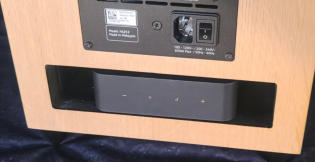

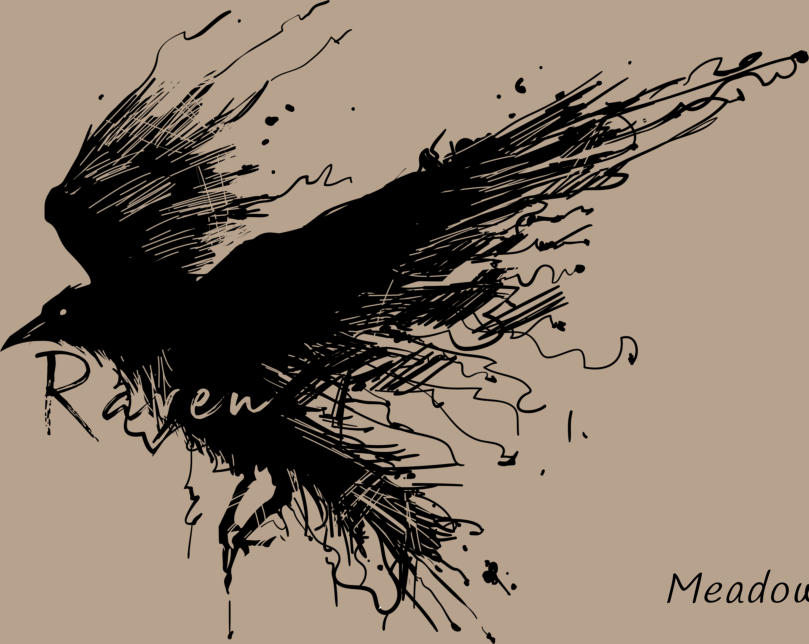
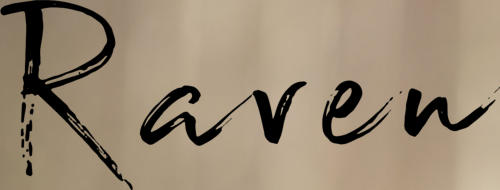

Here is a look at how we’re putting Raven’s large displacement to work. Check out the outrageous transfer function
we’re applying! This should give you an idea just how divergent our approach is from conventional thinking. A 5th
order Butterworth low pass filter brick-walls the subwoofers’ output from effecting the midrange. The 5th order
Butterworth high pass at 18Hz (!!!) lets us get away with 6dB of boost, making for a brutally robust bass
presentation with genuine full-range extension. That we can run Raven’s bass system up to full rated output with
this aggressive filter in place is amazing, even to us.
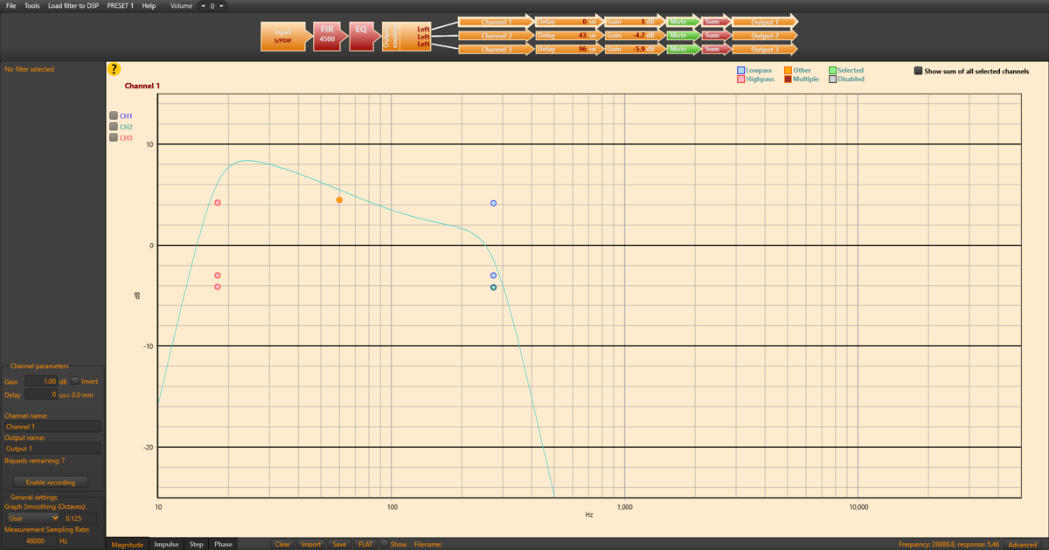
The new low moving mass SB Acoustics 4” midrange just sounds beautiful. Here are its filtered FA output and
Cumulative Spectral Decay. Smooth and natural with no discernible overhang, because there are no passive
components to screw things up; the midrange is directly coupled to its dedicated amp. Also, no discernible box
echo, none evident on the CSD; Raven’s highly damped triangular wave-trap effectively buries the backwave.
Squeaky clean and dripping wet midrange output.
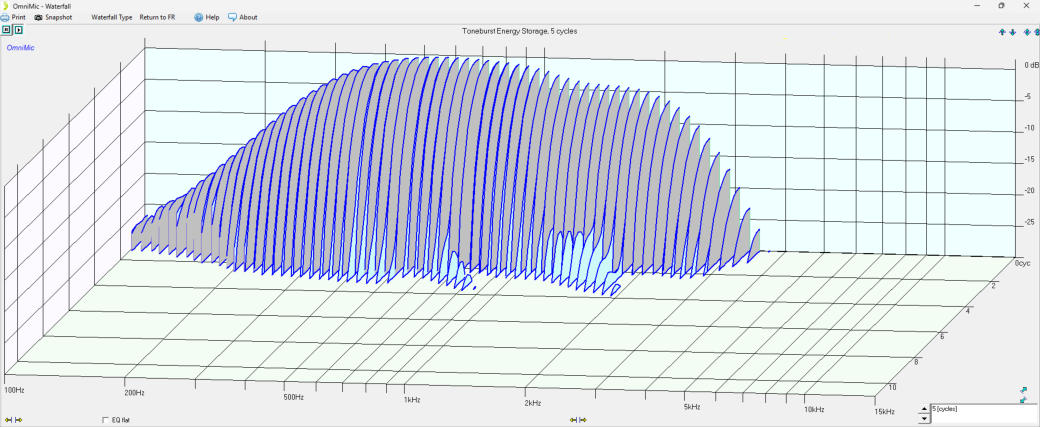
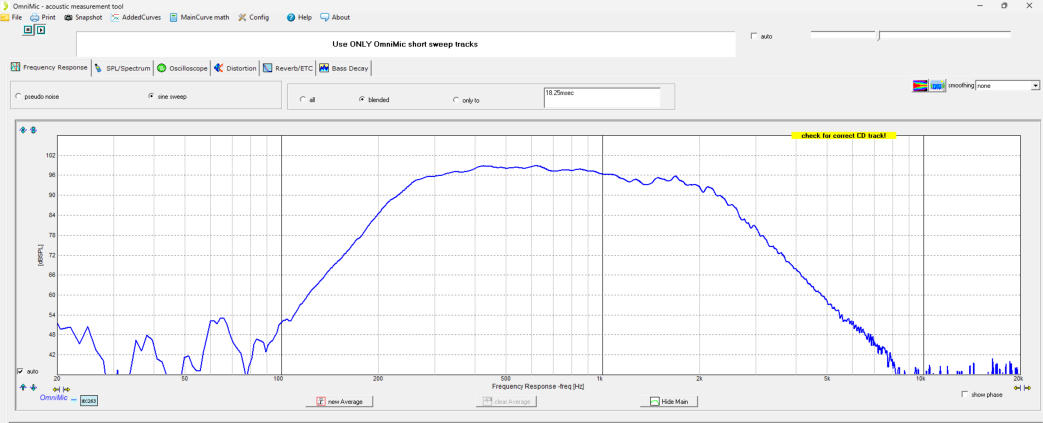
A FEW TECHNICAL POINTS OF INTEREST:
Here are a set of graphs, simplified for visual clarity, showing how we can use the choices DSP puts at our fingertips
when deciding how to employ a bass system’s displacement. A bass system’s displacement defines the limits of its
ability, a frontier upon which we are free to choose any combination of output and extension. Twin woofers, having
twice the displacement of a single one, allow us to choose some combination of both more output and more
extension. When we graduate to twin subwoofers - having twice the displacement of ordinary woofers - the options
at hand start to show a real advantage.
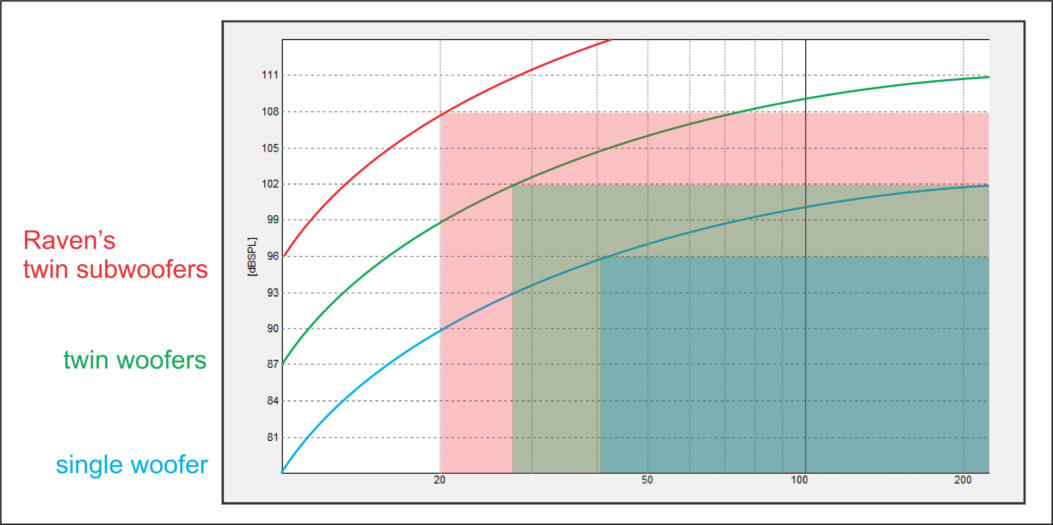
These days nearly all dome tweeters feature ferrofluid immersed voice coils, and for good reason: ferrofluid’s
function is to conduct heat away from the coil to prevent you from frying it. That is an essential property in
speakers with all but the steepest, hence nasty sounding, passive filters.
But, obviously, the coil might move freely if not immersed in oil. Happily, Seas offers a nonferrofluid variant of one
of my favorite tweeters. And, happily, we can impose a brick-wall filter in the processor, while the tweeter is directly
coupled to its own dedicated, treble optimized 100W NCore amplifier.
The sum is that Raven is just so darn much fun to listen to, so sweet, so brutal, so refined, so emotional, so
energetic.

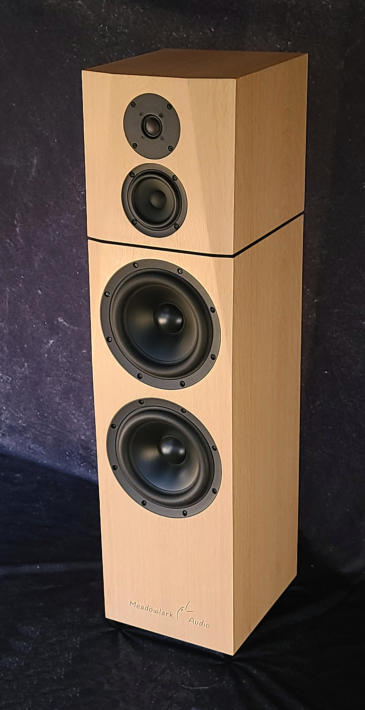
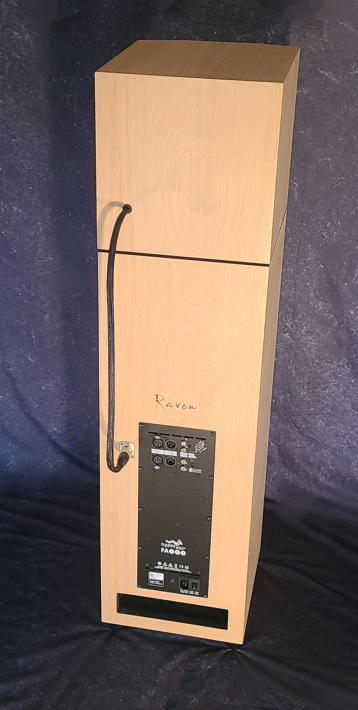
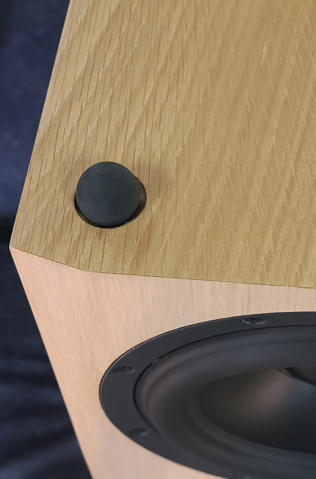
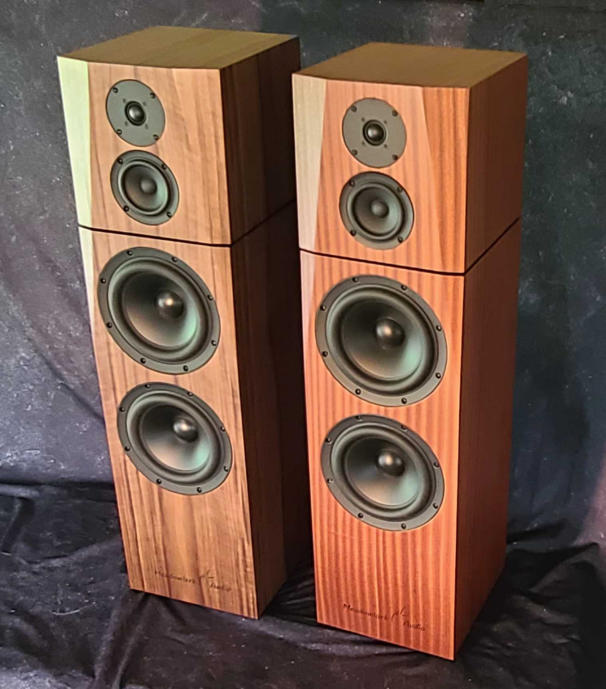
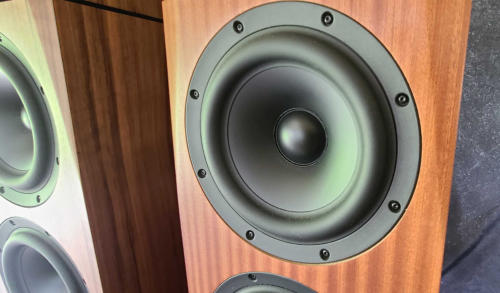
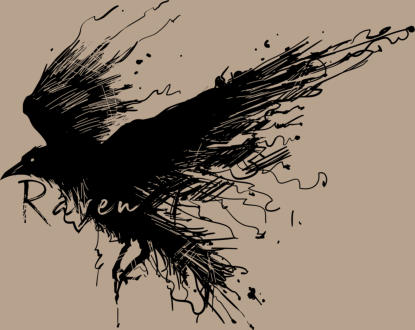
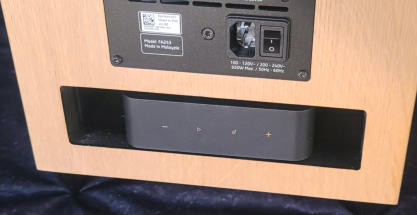
RAVEN BREAKS THE MOLD: A TWIN
SUBWOOFER, TRIAMPLIFIED THREE-WAY
Since the beginning of audio, a three-
way’s bass system had to be a woofer,
maybe two. A woofer is a driver that, by
design, must divide its duties between
making bass and doing a nice enough job
into the midrange to mate up with a
midrange driver. But those goals are
opposed, so a woofer is always a
compromise when it comes to making
bass. Limited by what could be done with
passive filters, you were stuck with the
consequence that, when the music gets
rough and the bass system reaches its
limits, you get congestion, strain and
glare.
But now, with twelve years of DSP
experience under our belts, bringing three
powerful NCore amps to bear, and
unbound by the ‘old rules’, we’ve taken a
leap. We’re not stuck with woofers; we
can use drivers that are designed for the
singular job of making bass: subwoofers.
Sure, they can’t make midrange. But we
don’t need it, we can dial the ideal filter to
marry the midrange to the bass system.
The result: Raven boasts twice the
displacement, or bass making capacity, of
its predecessors, which liberates the
entire speaker to exhibit expressive
dynamic range, vocal range beauty, and
genuine full range, tight and energetic
bass at amplitudes that will rock you.
But there’s more. There’s a factor quite
rarely discussed, but the one thing that
makes all great speakers great: top-to-
bottom cohesion. Meaning that: from top
to bottom, both resolution and dynamic
ability remain constant. No part of the
presentation is superior to the
rest. The whole speaker holds together as
one single thing. That’s what makes a
speaker truly ‘musical’.
Raven is my response to former
Meadowlark Audio lovers who have come
to the conclusion that they’re ready to
upgrade to a Next Gen Meadowlark, but
also have to mind a budget. We think
Raven’s price will surprise you. And you
won’t need to spend another nickel
adding subwoofers.
I think we really knocked it out of the
park with this one.
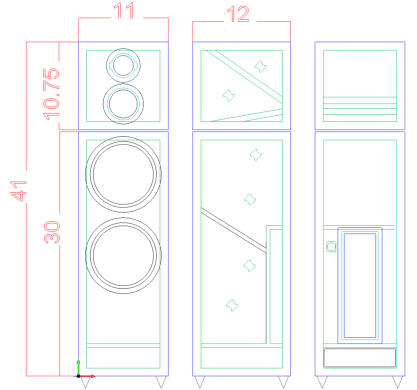
A FEW TECHNICAL POINTS OF
INTEREST:
Here are a set of graphs, simplified for
visual clarity, showing how we can use
the choices DSP puts at our fingertips
when deciding how to employ a bass
system’s displacement. A bass
system’s displacement defines the
limits of its ability, a frontier upon
which we are free to choose any
combination of output and extension.
Twin woofers, having twice the
displacement of a single one, allow us
to choose some combination of both
more output and more extension.
When we graduate to twin subwoofers
- having twice the displacement of
ordinary woofers - the options at hand
start to show a real advantage.
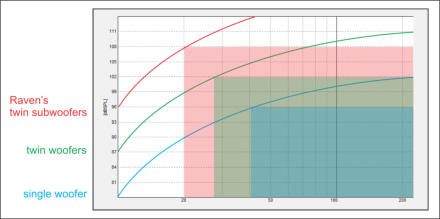
Here is a look at how we’re putting Raven’s
large displacement to work. Check out the
outrageous transfer function we’re
applying! This should give you an idea just
how divergent our approach is from
conventional thinking. A 5th order
Butterworth low pass filter brick-walls the
subwoofers’ output from effecting the
midrange. The 5th order Butterworth high
pass at 18Hz (!!!) lets us get away with 6dB
of boost, making for a brutally robust bass
presentation with genuine full-range
extension. That we can run Raven’s bass
system up to full rated output with this
aggressive filter in place is amazing, even
to us.
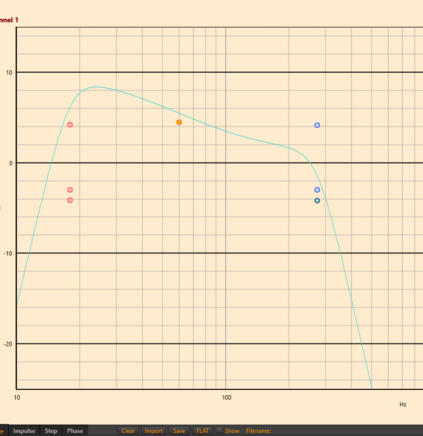
The new low moving mass SB Acoustics 4”
midrange just sounds beautiful. Here are
its filtered FA output and Cumulative
Spectral Decay. Smooth and natural with
no discernible overhang, because there are
no passive components to screw things up;
the midrange is directly coupled to its
dedicated amp. Also, no discernible box
echo, none evident on the CSD; Raven’s
highly damped triangular wave-trap
effectively buries the backwave. Squeaky
clean and dripping wet midrange output.
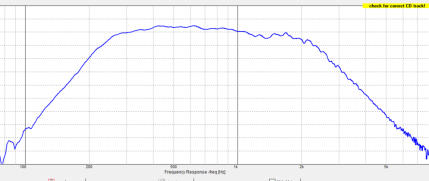
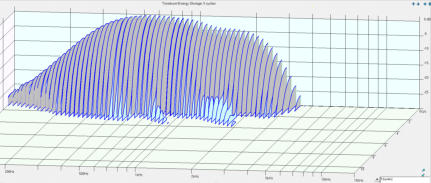
These days nearly all dome tweeters
feature ferrofluid immersed voice coils, and
for good reason: ferrofluid’s function is to
conduct heat away from the coil to prevent
you from frying it. That is an essential
property in speakers with all but the
steepest, hence nasty sounding, passive
filters.
But, obviously, the coil might move freely if
not immersed in oil. Happily, Seas offers a
nonferrofluid variant of one of my favorite
tweeters. And, happily, we can impose a
brick-wall filter in the processor, while the
tweeter is directly coupled to its own
dedicated, treble optimized 100W NCore
amplifier.
The sum is that Raven is just so darn much
fun to listen to, so sweet, so brutal, so
refined, so emotional, so energetic.




